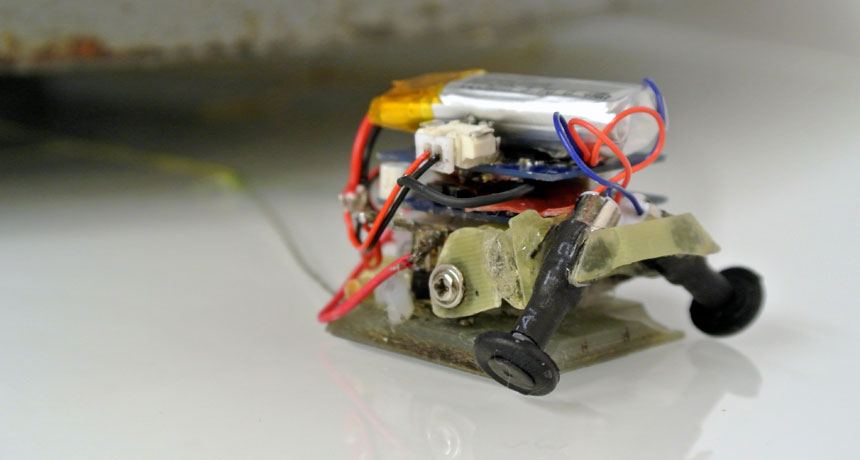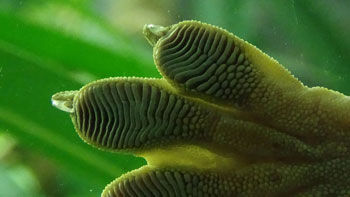Tiny microrobots team up and move full-size car
Scientists create itty bitty robots that work together like ants to move immense objects

This 29-millimeter (1.1-inch) long μTug microrobot pulled a 20.4-kilogram (45-pound) weight across a glass surface.
Karen Ladenheim/Biomimetics and Dexterous Manipulation Lab/Stanford University
A group of ants can move objects many times larger and heavier than themselves. This ability inspired a team of researchers to develop small robots that can do the same thing. The team created 29-millimeter (1.1-inch) long robots that can get a firm grip on the ground. In tests, six of the ‘bots have just worked together to tow a full-size car.
They didn’t move the car quickly. To haul it 12.5 centimeters (5 inches) took about one minute.
When ants carry a large item, such as a piece of food, they need good traction. To get a better grip, each ant presses its feet down harder. This increases the area of contact between each foot and the surface. Such ants served as the inspiration for David Christensen and his team of mechanical engineers at Stanford University in Palo Alto, Calif. (Mechanical engineers use physics and materials science to design tools and machines.)
Ants can cling to a smooth wall or surface using small pads on their feet. When an ant puts its foot down, a tiny droplet of sticky gel oozes between the pad and wall. This holds the ant in place. When walking, only tiny bits of the ant’s feet stick to the ground. That makes it easy for the ant to move quickly. The mechanical engineers wanted to create miniscule robots capable of moving big, heavy objects. But robots can’t ooze liquid the way ants do. Using sticky gel wasn’t an option for the tiny ’bots. So the researchers turned their attention to gecko feet.
Making sure-footed microrobots
The bottom of a gecko’s foot has layers of tissue covered with tiny hairs. When the critter puts weight on the foot, those structures spread out. This increases contact between the foot and the surface to which the gecko clings. That contact allows van der Waals forces to hold the foot onto the surface. Van der Waals forces are tiny electrical attractions between molecules. By increasing the surface area between its foot and a leaf, wall or other object, the gecko uses enough van der Waals force to stay in place. Such stickiness is called adhesion (Ad-HE-zhun).
Adhesion is one step, Christensen points out. But just as important is the ability to release the connection. Otherwise, he explains, “an insect or robot would become stuck and could not move.” So the team designed its robot based on the need to both stick and easily release its “foot.”

Flattening the wedges also added spring energy to them. Think of a spring that has been pressed together. When released, the coils burst apart. The same kind of energy in the wedges allowed them to spring loose when they were released.
The team ended up with a tiny robot that they called μTug. (In science, the Greek letter μ, or mu, means “micro”.) The μTug has a single foot and two wheels for traveling, plus a winch that could reel in a heavy object, known as a payload, which is connected by a string.
The μTug moves forward on its wheels then squats down, anchoring firmly to the ground with its foot. Now it uses the winch to haul the payload closer. The foot then releases and the string unwinds as the ’bot wheels forward. Then it stops and repeats the anchoring, winching and release.
By this means, the 12-gram (0.26-ounce) μTug was able to pull a 22.5-kilogram (50-pound) payload. That means the microrobot hauled nearly 2,000 times its own weight!
Working together
The next step was to see if μTugs could work together, as ants do. And if they could, were they better at doing so than other types of microrobots?
The team compared several kinds of microrobots: μTug, Hexbug Nano and Hexbug Scarab. Hexbug Nanos have 12 bristlelike legs. This allows them to jitter across the ground. Hexbug Scarabs have six legs that move independently. The researchers measured how well each robot could haul a payload.
Then the scientists put the different robots into teams. Each group initially had two robots, then three, then four. The researchers kept adding one and testing the group until they had tested six Scarabs (walking and running), six μTugs and 20 Nanos.
Hexbug Nanos and running Scarabs weren’t able to pull effectively in groups, Christensen found. Walking Scarabs performed better in larger groups than alone. That’s because walking robots stayed in contact with the ground. This gave them better traction as they pulled, allowing them to haul together in sync.
PULL TOGETHER NOW Watch six μTugs pull a car. bdmlstanford |
But the most successful teamed robots were μTugs. When working together, six of these could pull six times more than one μTug alone. This is due to their adhesive feet, which allows the microrobots to synchronize their pulling. In fact, those six μTugs pulled Christensen’s 1,800-kilogram (almost 4,000-pound) 2014 Chevy Volt.
The team reported its findings online on February 15 in IEEE Robotics and Automation.
“Cars take less force to move because of their wheels,” he explains. “That’s why the weight is so big compared to what you would expect for our robots,” he says. Without those wheels, six μTugs could slide only 12,000 times the body weight of a single μTug, or about 135 kilograms (298 pounds), across a glass surface. But it would take more than 4,000 Nano bristlebots to pull the same car, he notes.
Christensen says μTugs have potential for use in disaster relief. They could scurry through and search rubble. Then, he says, “They can work together in teams to move it off victims, open doors or turn safety valves.”
“This is exciting work,” says Aaron Becker. A computer engineer who was not involved with the study, he works at the University of Houston in Texas. The tiny robots are capable of producing astounding force, he notes. “I’d like to see [the researchers] describe how these robots can scale down to millimeter and micro-meter size.”
This is one in a series presenting news on invention and innovation, made possible with generous support from the Lemelson Foundation.







